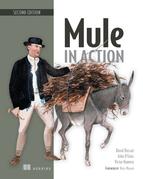Foreword
Secretly, my wife still harbors a little regret about the lost weekends I spent coding Mule, but without her Mule would not have been created and this book would not exist.
Like thousands of developers before me, I was continually struggling with the complexities of systems and application integration. The problem was that the proprietary solutions of the day—there were no open source alternatives back then—set out to address integration by adding another piece of complexity to the problem. These products made far too many assumptions about the environment and architecture, masking the ugliness with heavyweight tools, slick demo applications, and suave salesmanship. I used to spend long hours trying to work around integration products rather than being able to leverage them. This resulted in me venting to the point where my wife firmly suggested that I stop complaining and do something about it. A Mule was born.
Ten years on and Mule is the most widely used integration platform to connect any application, data service or API, across the cloud and on-premises. As SaaS, mobile, and big data converge, enterprises face a choice: become overwhelmed by the resulting explosion of endpoints or seize the opportunity to gain competitive advantage. Companies can no longer compete using only the assets, technology, and talent within their four walls. In the era of the new enterprise, companies must combine a surge of applications, data, partners, and customers into a single, high-performing entity.
Integration, services, and APIs have become critically important parts of application developers’ lives in the new enterprise. No application is an island, and increasingly applications will use data from 10 or more data sources and services from within and outside the company. Couple this with the rise of SaaS, mobile, and cloud computing, and we have an evolution from traditional application development to an assembly model, where data is served in many forms from many sources inside and outside of the firewalls.
Since the first revision of Mule in Action, MuleSoft has launched the Anypoint Platform to address a broader set of enterprise needs that includes SOA use cases such as legacy modernization and web services; SaaS integration to connect cloud and on-premises applications for data sync, batch, and process automation use cases; and API creation and publishing support for mobile APIs, B2B gateways, and device APIs. The product offering has been expanded with the introduction of RAML support and the API Designer, APIkit, and API Management. Some of these capabilities are outside the scope of this book, but at the core of the Anypoint Platform is Mule.
This book provides thorough coverage of all aspects of the Mule core runtime. It provides great examples of fundamental things you’ll most likely need to do with Mule, from creating and consuming services to working with various technologies such as JMS, web services, FTP, relational databases, and NoSQL. Importantly, it covers how to test, deploy, monitor, and tune Mule applications, topics that are critical for deploying Mule to production.
This book is also a great guide for anyone using CloudHub, the leading integration platform as a service (iPaaS). CloudHub has Mule at its core, so integration applications can run on Mule or CloudHub.
The great yet subtle element of this book is that the authors have captured the essence of pragmatism that is the founding principle of Mule. The notion that you can start small and build a complete enterprise or hybrid architecture over time is compelling. Each chapter explains the tools provided by Mule for building service-oriented applications. The chapters cover the spectrum: configuration basics, message routing, data transformation, publishing services, and creating RESTful APIs.
This publication marks a significant milestone for Mule. It demonstrates that the ideals of open source and community building really do work. The authors—David Dossot, John D’Emic, and Victor Romero—are long-time community members and have made many contributions to the project; this book is a significant and lasting addition. This is the must-have guide for all current and prospective Mule users; it explains all aspects of Mule without going into unnecessary detail, focusing on the concepts most important for building integration applications. Read on to learn how to unlock the power of Mule.
ROSS MASON
FOUNDER, MULESOFT
CREATOR OF THE MULE PROJECT
